Gentlepeople, stop your engines. The Beaverton School District’s (BSD) Safe Routes to School program is promoting an anti-idling campaign, encouraging students and parents to lead efforts against car idling during student drop-off and pick-up time.
Safe Routes to School, a national initiative to make it safe and fun for kids to walk and bike to and from school which has gained support in the Portland area, focuses a lot on the health and academic benefits of ditching the carpool line.
Advertisement
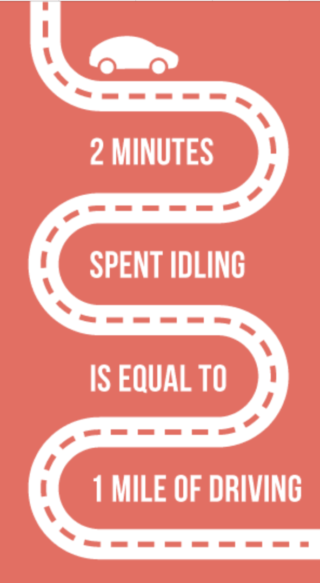
But the environmental impact of driving kids to school every day (and idling in the parking lot) shouldn’t be overlooked. Making it safer for kids to walk and bike to school is necessary for reducing people’s reliance on cars as their primary mode of transportation.
Car engine idling emits a lot more carbon than people might think. The U.S. Department of Energy says “while the impact of idling may be small on a per-car basis, the impact of the 250 million personal vehicles in the U.S. adds up.” If we could eliminate unnecessary idling from personal vehicles, it would produce the same emissions impact of taking 5 million vehicles off the roads.
Students who want to lead a campaign at their school will make materials based on data they gather observing people waiting in cars during pick-up time at their school. After an educational campaign and protest event, where students will hand out fliers to people in their cars, they’ll collect post-campaign data and see how things changed.
Kids can be very effective parent-persuaders, and since turning your car engine off is really not an arduous task, these campaigns could be impactful. As the global oil market is in upheaval because of the war in Ukraine and gas prices continue to rise, this is a good time to let people know how much gas they’re wasting just by sitting in their car with the engine running.
Find out more information from the BSD about how to begin one of these campaigns here.
And, to be clear, anti-idling campaigns don’t stop in Beaverton! The Portland Bureau of Transportation also encourages anti-idling awareness, as do school districts associated with regional Safe Routes to School programs.





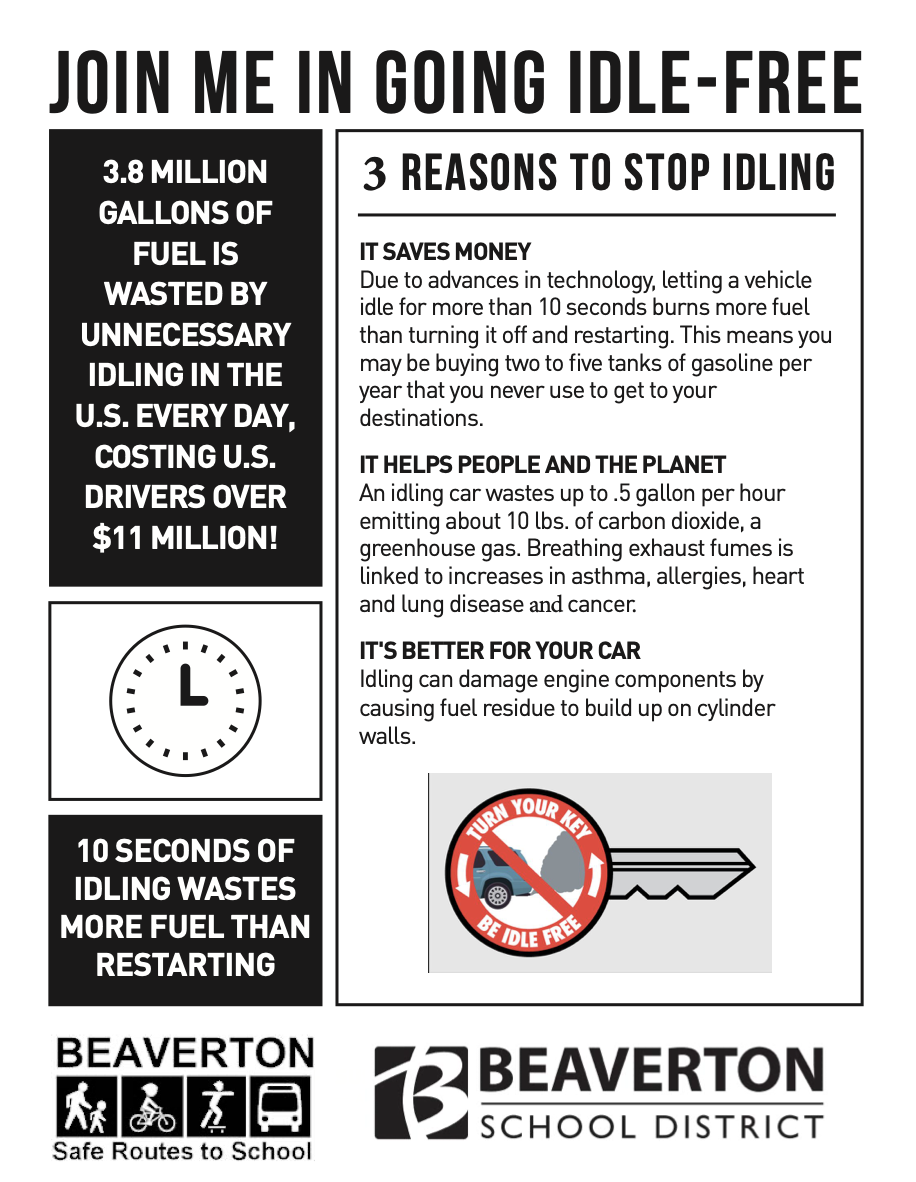
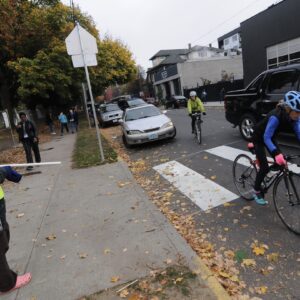
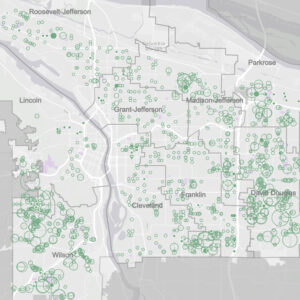

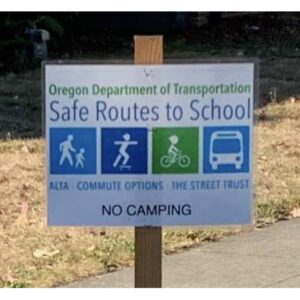
Thanks for reading.
BikePortland has served this community with independent community journalism since 2005. We rely on subscriptions from readers like you to survive. Your financial support is vital in keeping this valuable resource alive and well.
Please subscribe today to strengthen and expand our work.
I never understood the need to keep one’s engine going when just sitting and waiting. Whenever I used to pick up my child from school, I’d park, and turn my engine off. Others in the “line” would keep their engine going for some odd reason. Sometimes we’d be waiting 10 minutes or more.
In the old days, it was supposed to bad for the ignition and engine to repeatedly start the car.
Waaay back in the olden days when I learned to drive (70’s) we were taught to warm up the car for a minute or so before driving and idling at a stop for 5 minutes was normal. Cars have changed, but the people who teach new drivers and habits haven’t. Now it’s start and GO (zero warm up) and more than 30 seconds waiting?–shut it off. There is really NO downside to these new procedures but it’s a societal habit that is proving tenacious.
Correct, fuel injection is much more precise about air/fuel mixture and obviates the need to warm up the car from a cold start.
But cars not designed for stop-start generally have less robust starters and charging systems. Doing multiple stop-starts in succession will reduce the life of the starter and battery.
Manufacturers and regulators have decided that shifting the expense and impact of idling instead to designing stronger starters and making them easier to replace.
Personally I’d rather streets surrounding a school be closed to through traffic and drop-offs be more distributed around the edge. Kids, with or without their parents, can walk a block or two to school in safety without sitting in line wasting time and gas.
Why are cars used to take elementary school children to school. Busses are provided for students who are not within walking distance. I will believe gas prices are high and the good people of Oregon believe in global warming when there is not a line of SUV’s parked in the bike lane in front of the elementary school.
I have tried to bring up the dangerous and inconsiderate driving of parents dropping children off at school to the school and the Beaverton School district without any response. People concerned with school safety should take the following quiz: The leading killer of children in the USA is:
1) terrorists
2) gun violence
3) drivers
4) cancer
Every portland public school parent is aware of the inconsistencies of school bussing right now. It’s almost daily that we get a message from PPS telling us of a route not being driven this day.
Couple this with the increase in traffic dangers (likely due in part to less policing) and it’s not surprising that many parents such as myself chose to drive rather than bike.
I’m not alone in feeling that conditions in this city are not safe for kids to be riding to school. Open-air drug camps, Rampant drug-addiction, public mental illness, bike-theft and the lack of crime enforcement in this city are much greater concerns for parents like myself than the lack of bike infrastructure.
We know that idling around schools causes pollution. In comments on other articles, well-informed folks have asserted that congestion (i.e. idling on highways) does not cause pollution.
Can anyone from the congestion-does-not-create-pollution camp clarify how the school context differs from the highway context?
PS Please don’t drive your kids to school. Just don’t.
You are misstating the anti-freeway expansion / induced demand position. It is more nuanced than some magical belief that gridlocked freeways don’t pollute. They believe they don’t pollute *as much* as n+1 lane expansion projects.
No one is arguing that idling and stop-and-go traffic does not cause pollution. The argument is net pollution will increase if freeways are expanded because induced demand will result in more cars and more fuel burned than the current capacity.
There is no contradiction between the don’t idle in dropoff zones and don’t build more freeways positions.
Your explanation is clearly stated. I’m not sure I buy the argument without some numbers attached (and perhaps not even then as those numbers would be purely speculative and no better than numbers I could make up), but I understand the structure of the reasoning.
I do generally oppose highway expansion, but for more grounded reasons.
That’s was very well put. I’ll just add this link to an actual study measuring pollution before, during and after a highway expansion that puts this question to rest. Adding a lane to reduce congestion increases pollution even when it succeeds in reducing congestion for a short period of time. This study also makes the additional point that expanding a highway doesn’t reduce traffic on nearby streets it actually adds to it.
https://www.hindawi.com/journals/jat/2017/5161308/
There’s also these wonderful plot graphs from the city observatory that show there’s no correlation in increased congestion and increased pollution in cities. However there is plenty of correlation that an increase in VMTs increases pollution.
https://cityobservatory.org/urban-myth-busting_idling_carbon/
That article doesn’t “put the question to rest” as it says nothing about how any other potential widening would play out. I fully accept there are scenarios where widening would indeed increase pollution for the reasons stated. I am also convinced there are scenarios where it wouldn’t.
Distinguishing the two without a detailed site-specific analysis is difficult.
It’s not an article. It’s a study. An actual analysis of pollution on a congested roadway before and after roadway expansion. The idea that any study should have to prove how all other potential widening would definitively play out is absurd. You’re effectively asking to prove god doesn’t exist when you suggest a study should have to prove all widening projects will increase pollution.
You’re convinced there are scenarios where it wouldn’t because you want it to be that way. Despite the fact that the second link I provide has aggregate data from hundreds of cities about congestion and pollution showing no correlation. You’ve presented no evidence to support your belief and instead are asking others to prove your assertion is wrong.
I don’t believe you post here in good faith. This is some prove me wrong nonsense. I’ll get right on that after I prove god doesn’t exist.
Yes, it’s a study, and we appear to agree that it does not — cannot — speak to the general case, which is exactly my point.
The general case is essentially unprovable as the impacts of any particular project are highly site specific. That’s not what I “want”, it’s what is.
Does your second link (to an article) refute that? I don’t think so. It essentially asserts that reducing congestion without increasing miles driven (i.e. removing induced demand from the equation) would have no impact on emissions. One mechanism they suggest is that congestion acts like a speed limit, and by reducing top speeds to, say, 40mph, efficiency is increased. But congestion just as often reduces inefficient high speeds to even less efficient stop and go, with lots of acceleration and braking.
That congestion would have no impact on efficiency is so counter-intuitive that I’ll have to see more evidence to accept it. If it is in fact true, especially for electric cars (which is what all our long-range planning should be assuming) then it would probably be convincing.
What evidence would it take to convince you that in some circumstances, reducing congestion might also reduce emissions?
Idling is a serious problem all across our city. So many people sitting in their cars with the engines running while they’re on their phones. Seems like common sense to turn your engine off when you park, but even with high gas prices people still do it … a lot.
Seems like it should be banned and illegal to idle. Knowing full well that enforcement will be nonexistent, at least people may start to understand why it isn’t good for society. Are there any city initiatives in this direction? Are [diesel] trucks already banned?
I think car idling is primarily a psychological problem (truck idling is different). But turning your engine off, you are acknowledging you are staying for a while, and that may counter the “this will just take a second” lies about time we all tell ourselves.
While I agree that idling is a problem, I’ve put it in the category of things that will be fixed by electrification, and given the pervasiveness of the problem, I’m not sure how much effort it is worth investing in addressing it outside of targeted areas like schools.
Meh, this doesn’t do much. Most modern cars have engine stop/start technology anyway. Try again.
If the technology is so widespread, then why do I see parked cars with their engines running all the time?
“This doesn’t do much”
I don’t know how your school is set up, but at ours, the cars that are lined up to pick up kids just pump exhaust into the walk-up pick-up area for like 15-20 minutes. It’s gross, and yes: the cars are idling. (also, the exhaust flows into the covered-area and just sits there where the kids are standing.)
Not everyone has a ‘modern car’, and not every modern car has start/stop tech, and not every modern car that has start/stop tech has it engaged.
this issue is so widespread in the nw especially nw 23rd. its hard to pass a single block without someone idling nearby.